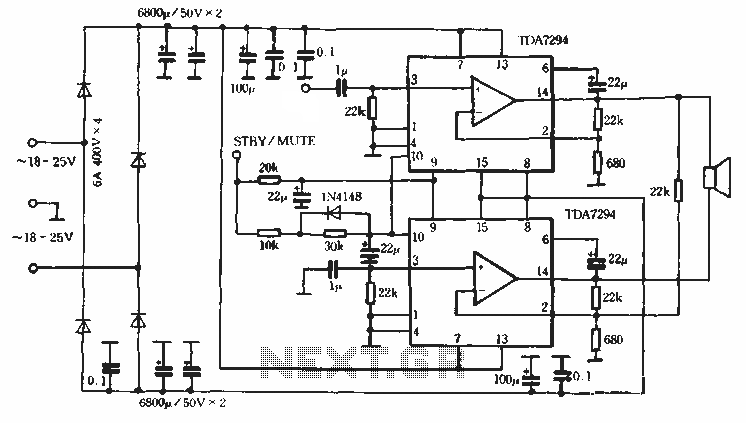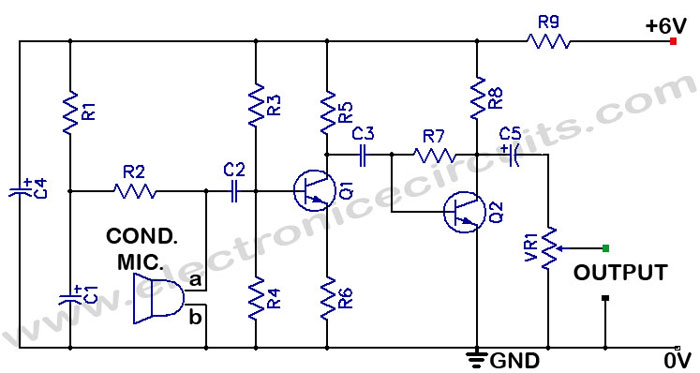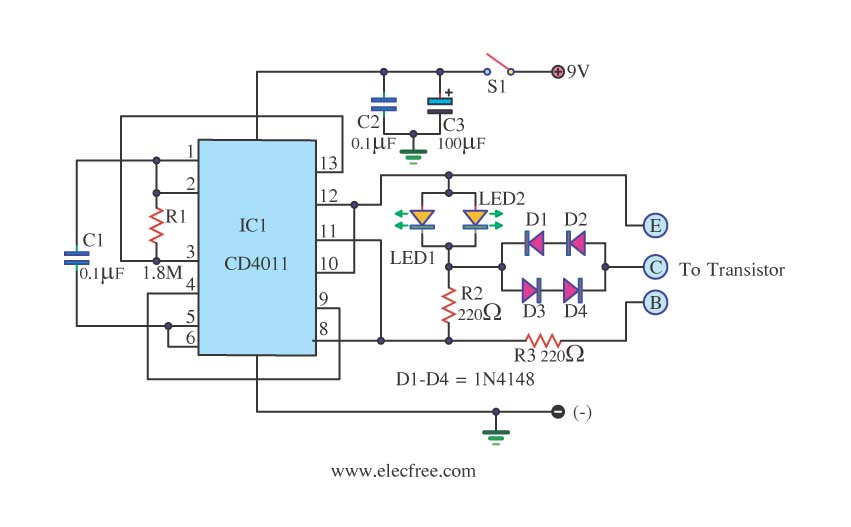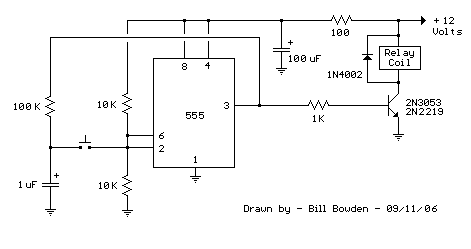
Simple light delay circuit 3
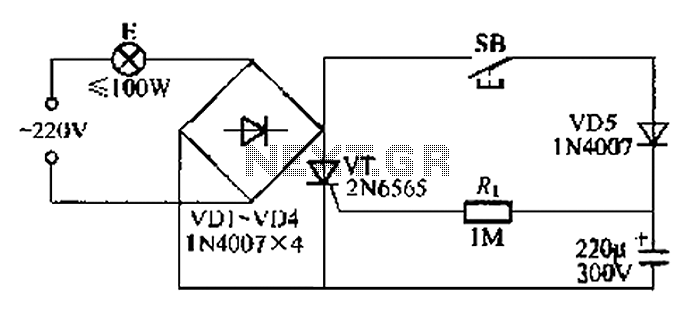
This circuit is a simple connection delay lamp circuit. When the lights are turned on and the switch is pressed, the power supply is activated. The capacitor charges rapidly, causing the thyristor (VT) to open, which in turn lights up the lamp (E). The capacitance allows the stored charge to discharge through the resistor (R) to the electrode of the thyristor, maintaining the thyristor in an open state. The lamp remains illuminated until the charge in the capacitor is substantially depleted. When the thyristor loses its trigger current, typically when the alternating current passes through zero, the lamp turns off. Suitable thyristors for this application include the 2N6565 and MCR100-8, which are micro-triggered unidirectional thyristors. The resistance value can be adjusted to change the delay time of the circuit. The capacitor must be rated for at least 300V, and an electrolytic capacitor is recommended. Care must be taken to avoid leakage currents, which could cause the lamp to turn off unexpectedly.
This connection delay lamp circuit utilizes a thyristor to control the illumination of a lamp based on the charge and discharge cycle of a capacitor. The circuit's operation begins when the power supply is activated by pressing the switch (F SH). The capacitor (C) charges rapidly through the power supply, and once the voltage across the capacitor reaches the triggering threshold of the thyristor (VT), it turns on, allowing current to flow through the lamp (E). This initial state keeps the lamp illuminated.
The stored charge in the capacitor is then discharged through a resistor (R) connected to the thyristor's gate. This discharge maintains the thyristor in its conductive state, allowing the lamp to remain lit even as the capacitor begins to release its stored energy. The duration for which the lamp stays illuminated depends on the capacitance value and the resistance in the circuit, which can be adjusted to achieve the desired delay.
As the capacitor discharges, its voltage drops. Once the voltage falls below the thyristor's holding current, the thyristor turns off, typically occurring when the alternating current waveform crosses zero. At this point, the lamp (E) turns off, completing the delay cycle.
The choice of thyristor is critical in this design. Thyristors such as the 2N6565 and MCR100-8 are recommended due to their micro-triggering capabilities and unidirectional conduction properties. The resistor value can be fine-tuned to modify the delay time, allowing flexibility in the circuit's response.
It is important to select a capacitor with an adequate voltage rating, specifically at least 300V, to ensure reliable operation. An electrolytic capacitor is preferred for this application, but care must be taken to prevent leakage currents, which can lead to premature lamp shutdown. Proper circuit design and component selection will ensure consistent performance and longevity of the delay lamp circuit.Another simple connection delay lamp circuit. Turn on the lights, press F SH, power supply by SH, VD. The capacitor (rapid charging, thyristor VT opened, lamp E lights up. Loos en SI3, capacitance (1 stored charge to the discharge electrode through the resistor R VT doors, so can maintain normal VT opened, the lamp E is still in the light emitting state when the charge is substantially C after release, VT trigger the loss of current, alternating current passes through zero ie when Ge off, turn off the lamp E. VT can be 2N6565, MCR100-8 type products and other micro-triggered thyristor unidirectional, shame get longer Q delay.
R or decrease (numerical called latency canthus Quine section of the circuit. withstand voltage of the capacitor C still needs to use an electrolytic capacitor to 300V in Bong circuit, electrolytic capacitor leakage current can cause the size of small lights off now dead elephant, the female energy is better than Lai inverted front.
This connection delay lamp circuit utilizes a thyristor to control the illumination of a lamp based on the charge and discharge cycle of a capacitor. The circuit's operation begins when the power supply is activated by pressing the switch (F SH). The capacitor (C) charges rapidly through the power supply, and once the voltage across the capacitor reaches the triggering threshold of the thyristor (VT), it turns on, allowing current to flow through the lamp (E). This initial state keeps the lamp illuminated.
The stored charge in the capacitor is then discharged through a resistor (R) connected to the thyristor's gate. This discharge maintains the thyristor in its conductive state, allowing the lamp to remain lit even as the capacitor begins to release its stored energy. The duration for which the lamp stays illuminated depends on the capacitance value and the resistance in the circuit, which can be adjusted to achieve the desired delay.
As the capacitor discharges, its voltage drops. Once the voltage falls below the thyristor's holding current, the thyristor turns off, typically occurring when the alternating current waveform crosses zero. At this point, the lamp (E) turns off, completing the delay cycle.
The choice of thyristor is critical in this design. Thyristors such as the 2N6565 and MCR100-8 are recommended due to their micro-triggering capabilities and unidirectional conduction properties. The resistor value can be fine-tuned to modify the delay time, allowing flexibility in the circuit's response.
It is important to select a capacitor with an adequate voltage rating, specifically at least 300V, to ensure reliable operation. An electrolytic capacitor is preferred for this application, but care must be taken to prevent leakage currents, which can lead to premature lamp shutdown. Proper circuit design and component selection will ensure consistent performance and longevity of the delay lamp circuit.Another simple connection delay lamp circuit. Turn on the lights, press F SH, power supply by SH, VD. The capacitor (rapid charging, thyristor VT opened, lamp E lights up. Loos en SI3, capacitance (1 stored charge to the discharge electrode through the resistor R VT doors, so can maintain normal VT opened, the lamp E is still in the light emitting state when the charge is substantially C after release, VT trigger the loss of current, alternating current passes through zero ie when Ge off, turn off the lamp E. VT can be 2N6565, MCR100-8 type products and other micro-triggered thyristor unidirectional, shame get longer Q delay.
R or decrease (numerical called latency canthus Quine section of the circuit. withstand voltage of the capacitor C still needs to use an electrolytic capacitor to 300V in Bong circuit, electrolytic capacitor leakage current can cause the size of small lights off now dead elephant, the female energy is better than Lai inverted front.
